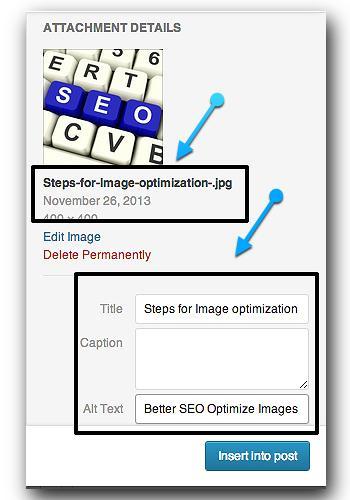 Including images in your website and blog content not only helps your content be more visually appealing and illustrate the points you’re making, images are also important for search engine optimization. When it comes to content marketing (and your corporate blogging) efforts in general, increasing your site traffic, improving search ranking and lead generation should be your focus. And adding images in your posts can make a big difference in the overall effectiveness of your site.
Including images in your website and blog content not only helps your content be more visually appealing and illustrate the points you’re making, images are also important for search engine optimization. When it comes to content marketing (and your corporate blogging) efforts in general, increasing your site traffic, improving search ranking and lead generation should be your focus. And adding images in your posts can make a big difference in the overall effectiveness of your site.
The good news? Optimizing images for search on your WordPress website or blog is not really that difficult. You may have heard or read about the importance of optimizing your images, but most people don’t bother to do it. That’s a big mistake!
Why should you care about optimizing your images on your WordPress site?
Optimizing your images will speed up load times on your website or blog. The bigger the size of your image file, the longer it will take your site to load and this can (and will) cause visitors to abandon your site. According to a study by KissMetrics, 47% of consumers expect a web page to load in two seconds or less and 40% of visitors abandon a website altogether that takes more than three seconds to load. That’s serious business—and a great reason to optimize your images.
Most bloggers know it’s important to optimize their blog posts with keywords in both the title and body of the post. Just as important is to add keywords to your images to make it easier for search engines like Google to properly index those images. It’s really easy once you know what to do. Here are some simple steps you can take to optimize your images on WordPress:
Step 1 – Resize and format images properly
Once you’ve chosen a particular image to use on your blog, you’ll need to use an image editing tool to properly resize the image. In order to get the optimal size for your blog post, you’ll need to determine how wide your post display area is and scale your image accordingly. Some great free tools available to help you include Online Image Optimizer and Pixlr. You can also use Smush.it, a WordPress plugin that provides a one-step solution for compressing images and optimizing different file formats.
Step 2 – Name your image properly
After you’ve resized your image, it’s important to name your file properly. As mentioned earlier, if you want your images to be properly indexed by search engines, you need to use keywords that accurately describe your images. Sounds so simple, yet you’d be surprised how many people overlook this important step. If you’re using an image that came from your camera or an image that you purchased, the file name usually consists of an exciting and random series of numbers and letters such as: (IMG_1959.jpg or iStock_000000354999Small.jpg.) This “fix” is so stinking easy — instead of leaving the file name as is, change it using a keyword rich file name that will tell the search engines what your image is about (and how it’s relevant to the post you’re writing). And just like your blog post titles, it’s equally as important to use a descriptive file name for your images, preferably a keyword you want your image to rank for.

Step 3 – Fill out search engine related fields for images completely on the WordPress “Add Media” panel
Once you upload the appropriate image, make sure you fill in completely all the search engine related information fields. This includes the title, alt text and image description fields and it’ll take you approximately an extra 20 seconds to do this right. And it’s important because this allows search engine spiders to recognize and index your images. Adding descriptive text in the alt tag field also helps search engines accurately understand what your image is all about. These are little things, but when it comes to overall search engine optimization for your content and your images, they are the important things.
Important Things To Remember
Aside from the steps outlined above, there are some additional key points you need to remember:
- Always use relevant images. Also, consider using captions on your images based on relevancy to the article, which will help prevent high bounce rates.
- Use a variety of keywords. Avoid using the same words over and over again.
- And most importantly, don’t use images that you don’t have the right to use. Just because you find something on the Internet, doesn’t mean it’s up for grabs for you to use and there can be a serious downside (not to mention serious penalties) when it comes to using images that you don’t have permission to use. My good friend Sara Hawkins, who’s also conveniently an attorney, wrote a terrific post about this for Social Media Examiner called Copyright Fair Use and How It Works for Online Images. You should read it.
Final Thoughts
Great writing and an understanding of search engine optimization is just one part of your overall content marketing strategy. And a big part of maximizing your blog’s seo will rely on having a checklist that includes image optimization. The good news is that once you learn how to do it, optimizing images for your WordPress site or blog will be second nature and take you just a few extra minutes per post.
What about you? Are you currently optimizing the images you use in your content marketing and corporate blogging efforts? If not, do you think you’ll start?
Other resources on this topic:
SearchEngineLand: Are You Keeping Secrets from the Search Engines?
HubSpot: 8 Ways to Instantly Improve the Social Shareability of Your Blog Content
V3 Blog: Need Blog Images? Use Compfight to Search Flickr
photo credit: SEOPlanter via photopin cc
Want Better SEO: Optimize the Images on Your WordPress Site is a post from: V3 Kansas City Integrated Marketing and Social Media Agency

